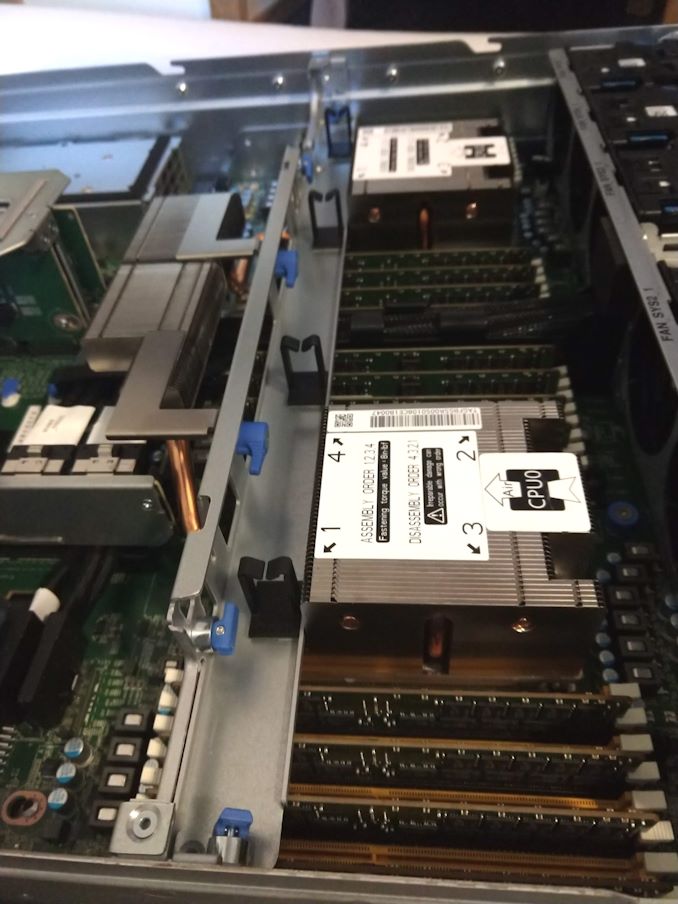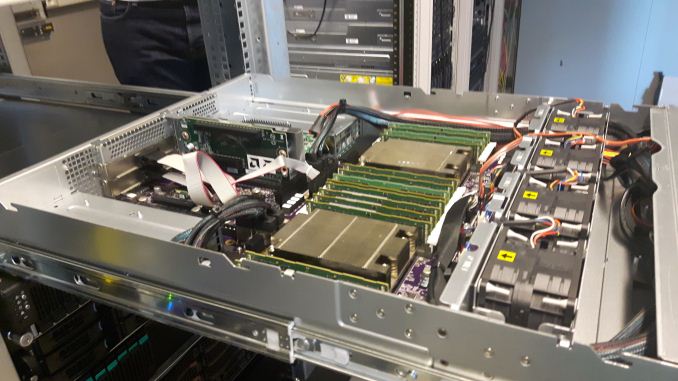AMD Rome Second Generation EPYC Review: 2x 64-core Benchmarked
by Johan De Gelas on August 7, 2019 7:00 PM ESTMurphy's Law
Anything That Can Go Wrong, Will Go Wrong
For those of you that may not know, I am an Academic Director of MCT at Howest University here in Belgium. I perform research in our labs here on big data analytics, virtualization, cloud computing, and server technology in general. We do all the testing here in the lab, and I also do launch article testing for AnandTech.
Undoubtedly, like most academic institutions, we have a summer vacation, where our labs are locked and we are told to get some sunlight. AMD's Rome launch has happened just as our lab closing started, and so I had the Rome server delivered to my home lab instead. The only issue was that our corresponding Intel server was still in the academic lab. Normally this isn't really a problem - even when the lab is open, I issue testing through remote access and process the data that way, in order to reboot the system and run tests and so forth. If a hardware change is needed, I need to be physically there, but usually this isn't a problem.
However, as Murphy's Law would have it, during testing for this review, our Domain Controller also crashed while our labs were closed. We could not reach our older servers any more. This has limited us somewhat in our testing - while I can test this Rome system during normal hours at the home lab (can't really run it overnight, it is a server and therefore loud), I couldn't issue any benchmarks to our Naples / Cascade Lake systems in the lab.
As a result, our only option was to limit ourselves to the benchmarks already done on the EPYC 7601, Skylake, and Cascade Lake machines. Rest assured that we will be back with our usual Big Data/AI and other real world tests once we can get our complete testing infrastructure up and running.
Benchmark Configuration and Methodology
All of our testing was conducted on Ubuntu Server 18.04 LTS, except for the EPYC 7742 server, which was running Ubuntu 19.04. The reason was simple: we were told that 19.04 had validated support for Rome, and with two weeks of testing time, we wanted to complete what was possible. Support (including X2APIC/IOMMU patches to utilize 256 threads) for Rome is available with Linux Kernel 4.19 and later.
You will notice that the DRAM capacity varies among our server configurations. This is of course a result of the fact that Xeons have access to six memory channels while EPYC CPUs have eight channels. As far as we know, all of our tests fit in 128 GB, so DRAM capacity should not have much influence on performance.
AMD Daytona - Dual EPYC 7742
AMD sent us the "Daytona XT" server, a reference platform build by ODM Quanta (D52BQ-2U).
| CPU | AMD EPYC 7742 (2.25 GHz, 64c, 256 MB L3, 225W) |
| RAM | 512 GB (16x32 GB) Micron DDR4-3200 |
| Internal Disks | SAMSUNG MZ7LM240 (bootdisk) Micron 9300 3.84 TB (data) |
| Motherboard | Daytona reference board: S5BQ |
| PSU | PWS-1200 |
Although the 225W TDP CPUs needs extra heatspipes and heatsinks, there are still running on air cooling...
AMD EPYC 7601 – (2U Chassis)
| CPU | Two EPYC 7601 (2.2 GHz, 32c, 8x8MB L3, 180W) |
| RAM | 512 GB (16x32 GB) Samsung DDR4-2666 @2400 |
| Internal Disks | SAMSUNG MZ7LM240 (bootdisk) Intel SSD3710 800 GB (data) |
| Motherboard | AMD Speedway |
| PSU | 1100W PSU (80+ Platinum) |
Intel's Xeon "Purley" Server – S2P2SY3Q (2U Chassis)
| CPU | Two Intel Xeon Platinum 8280 (2.7 GHz, 28c, 38.5MB L3, 205W) Two Intel Xeon Platinum 8176 (2.1 GHz, 28c, 38.5MB L3, 165W) |
| RAM | 384 GB (12x32 GB) Hynix DDR4-2666 |
| Internal Disks | SAMSUNG MZ7LM240 (bootdisk) Micron 9300 3.84 TB (data) |
| Motherboard | Intel S2600WF (Wolf Pass baseboard) |
| Chipset | Intel Wellsburg B0 |
| PSU | 1100W PSU (80+ Platinum) |
We enabled hyper-threading and Intel virtualization acceleration.












180 Comments
View All Comments
Cooe - Thursday, August 8, 2019 - link
Hexus got around ≈31,000 iirc.Ryan Smith - Thursday, August 8, 2019 - link
Funny enough, from what I've heard from other people who have tested it, it actually doesn't run all that well with dual EPYCs. Too many cores that are too fast, to the point that initialization times are starting to hold back performance.Ian Cutress - Thursday, August 8, 2019 - link
I got a message from the Cinebench team at one point. They don't spawn/kill/respawn for each little segment: it's kept alive and just fed more data. CB20 is also designed to scale, given that CB15 freaked out above 32 cores or soprisonerX - Wednesday, August 7, 2019 - link
Where is our resident Intel shill? Selling his INTC stock in a panic perhaps?abufrejoval - Wednesday, August 7, 2019 - link
comiserating with the ARM server guysLord of the Bored - Thursday, August 8, 2019 - link
Not gonna lie, I scrolled straight to the comments to see the Intel fanboy spinning this. Instead I got a wall of... Call of Duty references, I think?PeachNCream - Friday, August 9, 2019 - link
The fact that AMD released a product that breaks even HStewart's ability to defend shill for Intel should say something pretty epic about Epyc.Lord of the Bored - Saturday, August 10, 2019 - link
You ain't lyin' there. Seems the name was chosen well.Korguz - Saturday, August 10, 2019 - link
i bet, he would STILL but the intel cpu too. even though it costs more, slower and probably uses more power.Samus - Thursday, August 8, 2019 - link
I was just thinking if Trump doesn't crash the market with his shenanigans then AMD could be an incredibly good buy in the next few months. The first time they've been a good buy in awhile.Although a lot of my daytrader friends have always claimed AMD was a good short-term buy, which is partially true, but if they can keep momentum and Intel doesn't try strongarming them out of OEMs (you know, like they used too...)